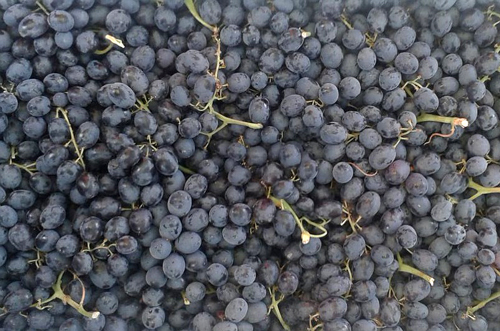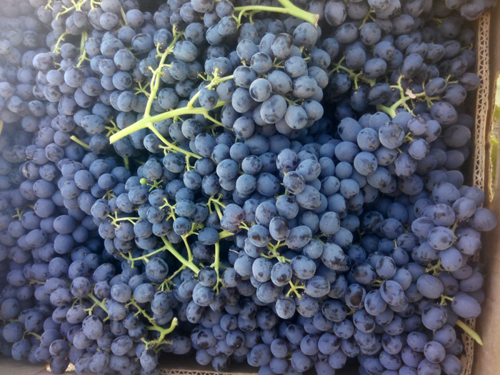Grape variety Black Kishmish
Black kishmish is one of the oldest traditional grape varieties of the eastern ecological-geographical type, cultivated in the Central Asian republics since time immemorial. For hundreds of years of cultivation, it has spread in many areas, where it became known under a variety of names: Shuvargan, Kara-kishmish, Black Monukka, Kishmish this. In the post-Soviet space, the variety is actively cultivated in Uzbekistan and Tajikistan, to a lesser extent in Kyrgyzstan and Turkmenistan. In most of these countries, it is zoned and introduced into the standard assortment. Outside of the main distribution area, it is sometimes cultivated by hobbyists experimenting with exotic forms of grapes.
The origin of the variety is currently unknown, it is only assumed that it originally appeared in Central Asia together with the Turkic tribes who were developing these territories. Subsequently, it was actively used in crossing as a paternal form to obtain new high-quality hybrids of the sun berry.

The main advantages of Black Kishmish, which determined its popularity, are high yield and excellent gastronomic characteristics of fresh and processed fruits. But, at the same time, like many other oriental seedless varieties, it is distinguished by its extreme delicacy and low resistance to unfavorable environmental factors. In this regard, its cultivation requires a competent approach from the grower and careful implementation of the necessary measures for caring for plants.
Agrobiological characteristics
The growth vigor of the grape bushes is high. The leaf is medium in size, as a rule, rounded, consists of three or five lobes raised upward, the dissection between which is strong. The profile of the leaf blade is funnel-shaped or strongly wavy. The front side of the leaf is dark green, reticulate-wrinkled, the back is naked, not pubescent. The upper lateral incisions are medium or deep, more often open lyre-shaped with a rounded bottom, less often closed with an ovoid lumen. The lower notches are small or medium, in most cases they have the shape of a reentrant angle. The petiole notch is closed, practically without a gap, sometimes slit-like. Petioles are of moderate length, light green, without bright anthocyanin shades. The teeth along the edges of the leaf are triangular and sawtooth, have convex edges and sharp tops. The flowers are bisexual, and therefore do not experience problems with fertilization, forming well-executed clusters without signs of pea berries. Falling buds and ovaries also do not occur. The annual vine ripens on time and to a sufficient length, while turning brown with darker nodes than internodes.
Bunches of grapes do not differ in gigantic size, reaching an average weight of about 300-400 grams, have a conical or cylindro-conical shape, sometimes with wings. The structure of the black Kishmish brush can be from moderately loose to quite dense. At the same time, the appearance is very neat and attractive due to the excellent uniformity of the berries. Crests of moderate length, green, herbaceous. The grapes are medium, oval with flattened bases and rounded tops. They reach 15-17 mm in length and 12-13 mm in width. Painted almost black and covered with a thick layer of a protective spring of a bluish tint. The average weight of 100 berries is 250-300 grams. Due to the not too tight fit to each other, damage and deformation of the grapes is not observed. The pulp is dense, oriental crisp with a noble refined taste and neutral aroma. The juice squeezed out of the fruit is very sweet - the amount of sugars ranges from 22-27 g / 100 ml, while the acidity is quite low - 4-5 g / l. The skin is thin, barely noticeable when eaten. the seeds do not develop, due to which the variety belongs to the highest class of seedlessness and has excellent taste.The tasting characteristics of both fresh and dried products always deserve the highest marks.

The resulting crop can be used in a variety of ways. As a dessert grape, Black Kishmish is very popular for direct consumption. Manufacturers sell it on the local market and export it in large volumes abroad. This is facilitated by the high transportability of the bunches, due to which they do not lose their presentation at all after moving over long distances. Its keeping quality is average, and in order to achieve significant storage periods, it will be necessary to reduce the temperature in the room to + 1 ... + 3 ° С. As a raw material for processing, our hero shows himself perfectly when drying. Highly sugar-rich berries provide an exceptional taste to the finished dried fruit. The output of raisins reaches 25-30% of the weight of the crop. Drying is done mainly in the sun without pretreatment, resulting in a variety called Shagani. And finally, certain volumes of this grape are used in winemaking. A wide variety of types of drinks are obtained from it: dry and with residual sugar wines, ports, Cahors. However, in a varietal form, they are not always of high quality, and therefore are used only in a blend with other wine materials.
The ripening period of our hero is estimated as relatively early due to the fact that the duration of the growing season from budding in spring to the onset of removable ripeness is 125-130 days. But at the same time, it must be borne in mind that in the regions familiar to oneself, it grows in conditions of sweltering heat, and therefore the sum of active temperatures by the time of ripening can reach 3000-3500 ° С. In our country, such indicators are characteristic only for the south itself, in connection with which it makes sense to carry out experiments on the cultivation of the Central Asian variety only in the regions with the most warmth. And here you can count only on the table use of the grape harvest, while to obtain high-quality dried fruits, an even higher level of SAT is required. In addition, do not forget about the very low frost resistance of Black Kishmish. His vine gets significant damage already at -16 ° C, and at -18 ° C uncovered bushes die. This feature makes amateur winegrowers take very seriously the issue of warming plants in the cold season.
The yield of the variety is another great aspect of it. In conditions of a suitable climate, good care and irrigation that is mandatory for arid regions, the productivity of a vineyard can reach 30 tons per hectare. Such a high indicator is possible, among other things, due to the fact that in the Central Asian republics the bushes can be left uncovered for the winter and given the opportunity to accumulate large volumes of perennial wood, which has a very positive effect on both large-fruited and the ability of plants to bear a truly colossal load. Domestic growers are limited in such opportunities, which is why they get very modest yields on relatively compact covering formations. Moreover, here the bushes can show a tendency to overload, reducing the activity of shoot growth, lengthening the growing season and deteriorating the quality of the grapes. This requires additional attention from the owner and a sensitive reaction to such problems.
Ripe berries practically do not crack even in rainy weather, and therefore they can continue to hang on the bushes for a long time. In this case, measures should be taken against gray rot, because without this, the grapes can start to spoil. Wasps also do not bypass our hero, which is why the crop must be protected from them.
Agrotechnical features
As already mentioned, Black Kishmish is a very picky variety, and this is especially true of attempts to cultivate it in regions that are not traditional for it.
When choosing a place for planting grapes, first of all, it is worth evaluating the site in terms of heat supply. The best, and in some cases the only possible option, will be the use of southern slopes, where the sum of active temperatures turns out to be several hundred degrees higher compared to the plains. The same effect can be achieved by placing bushes in the southern walls of houses or other buildings, as well as capital fences. It is imperative to provide for the possibility of reliable insulation of bushes for the winter, for which, from the first years of life, they are formed according to special non-standard covering schemes.
Fruit arrows of the plants that have entered fruiting are cut long - by 10-15 buds. The total load is regulated depending on the age, size and vital energy of specific bushes. Against fungal diseases of grapes, especially against oidium and anthracnose, multiple treatments of the variety are carried out with fungicides, some of which are supplemented with insecticidal preparations against the grape leafworm.








